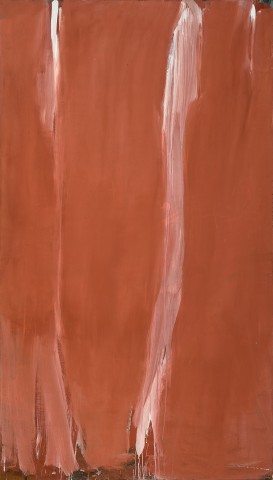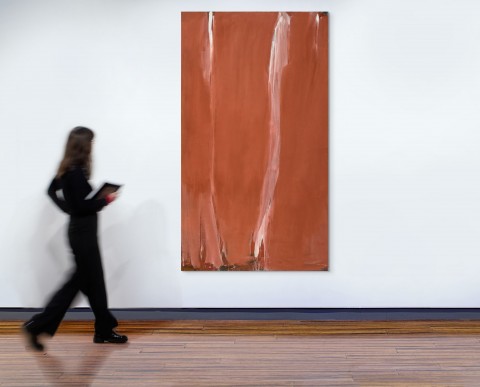TWO FAINT LINES ON BROWN (TP85), 1970 – 73
TONY TUCKSON
synthetic polymer paint on composition board
213.5 x 122.0 cm
Private collection, Sydney, a gift from the artist in 1973
Tony Tuckson, Watters Gallery, Sydney, 11 April – 5 May 1973, cat. 20
Tony Tuckson 1921 – 1973, a Memorial Exhibition, Art Gallery of New South Wales, Sydney, 10 April – 9 May 1976, cat. 87 (label attached verso)
Two Centuries of Australian Painting, Orange Regional Gallery, New South Wales, 19 April – 15 June 1986
Tuckson: The Abstract Sublime, Art Gallery of New South Wales, Sydney, 1 November 2018 – 17 February 2019
Thomas, D., Legge, G., & Free, R., Tony Tuckson, Craftsman House, Sydney, 1989, pl. 147 (illus.), p. 126
Mimmocchi, D., Tony Tuckson: The Abstract Sublime, Art Gallery of New South Wales, Sydney, 2018, pp. 52, 71, 140 (illus.), 208
If Tony Tuckson had failed to produce his final late abstractions, he would be admired as an inspired Modernist where the figure predominated. Paintings which were created with an interest in the School of Paris, Picasso and Matisse in particular.
In 1948 he studied under Grace Crowley and Ralph Balson at East Sydney Technical College where his instinctive curiosity responded to their theories on colour and abstraction. A year later he saw the exhibition ‘Arnhem Land Art’ at David Jones Gallery, Sydney. These moments preceded his interest in New York School lyrical abstraction, yet they appear to share a defining prescience in the making of Two faint lines on brown, 1970.
It is the perfect synthesis, a sublime culmination of his unique abstraction, where in the year it was painted and exhibited at Watters Gallery, Sydney, the paintings attracted immediate and unreserved critical acclaim which has never diminished.
Accounts of Tuckson’s professional role at the Art Gallery of New South Wales, his perceived conflict as a practising artist and working duties, is well recorded. He chose not to exhibit, nonetheless his private and prolific studio activity continued. His role in defining the place of Indigenous art in the AGNSW’s displays and collections was transformative. He hoped to narrow his role there and oversee Aboriginal art and his ever-developing interest in Oceanic and Melanesian art.
Two faint lines on brown, 1970 is a transcendent marker of Tuckson’s vast interests, where nothing becomes a stylistic prompt and his impulsive expression reaches its most individual and resolute form.
Other major works from this time include the celebrated double-panel works, where the composition of vertical lines is complemented by sweeping horizonal gestures. Aside from the wonderful overall sgraffito painterliness, two other factors are always in play in Tuckson’s late work – scale itself and surface edges – our physical relationship to his painterly monumentalism is an important dynamic.
In Two faint lines on brown the chalky dry surface is subtle, rich in nuance and evocative of two interests central to Tuckson’s artistic and cultural preoccupations. The New York School (whose work he experienced when he visited in 1967 – 68), and by this stage, his two-decades long association with Aboriginal art (he had visited Yirrkala in the late 1950s).
While pictorial literalism is something Tuckson avoided, it is not a stretch to connect these interests. Intuitive influences were never stylistic grabs, rather the result of art and cultures seen and experienced from personal encounters. ‘‘Contact between two cultures may not be reciprocal’ he stated, ‘but it can have considerable influence.’ This may well have been a statement in relation to his own painting…’’1
Tuckson admired the work of Barnett Newman whose so-called ‘zip’ paintings were often vast canvases that were larger in scale and reach than most viewers themselves. It is no coincidence that Newman was keenly interested in, and even curated an exhibition on, the native art of Northwestern America.
The irregular falling vertical lines in our work cascade to an ensemble of lyrical, splashed and dribbled gestures at the base at its lowest edge. Whether we see it as coincidence or a discreet gesture of respect, the association with the narrow, vertical eastern Arnhem Land Mokuy figure seems inescapable. Tuckson first visited Yirrkala and Melville Island in the late 1950s.
Two faint lines on brown is a sophisticated masterpiece – an encapsulation of what immediately defined his reputation as an abstractionist at the forefront of Australian painting from the moment his final works were seen.
1. The artist, cited in Mimmocchi, D. et al., Tony Tuckson, Art Gallery New South Wales, Sydney, 2018, p. 20
DOUG HALL AM

